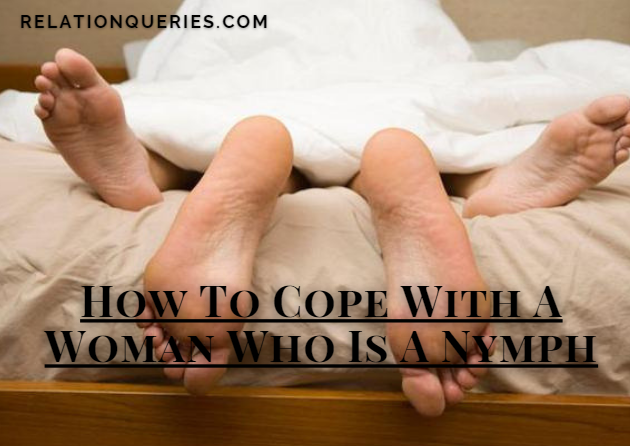
How To Tell If A Woman Is A Nymph:- In today’s world, discussions about human sexuality are becoming more open and accepted.
One aspect that often sparks curiosity and intrigue is nymph or we can say nymphomania, a term that refers to hypersexuality or excessive sexual desire in women.
While the concept of nymph-omania has evolved over time, it’s essential to approach it with sensitivity and understanding.
In this article, we will talk about 20 Signs That Tell If A Woman Is A Nymph (nymphomania) and provide explanations to better comprehend this complex phenomenon.
What Is Nymph?
Before we explore the signs, it’s crucial to understand what Nymph (Nymphomania) is. Nymph, also known as hypersexuality, is a psychological condition characterized by an intense and often uncontrollable desire for sexual activity.
It involves an excessive preoccupation with sexual thoughts, fantasies, and behaviors, which can significantly impact an individual’s daily life, relationships, and overall well-being.
Nymph is not limited to any specific gender and can affect both men and women.
Key Features of Nymph
- Excessive Sexual Desire
- Compulsive Behaviors
- Difficulty Controlling Sexual Urges
- Interference with Daily Life
- Impact on Relationships
- Potential Emotional Distress
Signs That Tell If A Woman Is A Nymph
1. Frequent and Intense Sexual Fantasies
One of the significant signs that might indicate if a woman is a nymph is the presence of frequent and intense sexual fantasies.
These fantasies go beyond the realm of typical daydreaming or occasional thoughts about intimacy. Instead, they involve vivid and often explicit scenarios that occupy a woman’s mind regularly and persistently.
These fantasies can be incredibly detailed, involving various scenarios, partners, and settings. They may range from romantic encounters to more adventurous and unconventional situations.
The key characteristic is the intensity and frequency with which these sexual thoughts arise.
It’s important to note that having sexual fantasies is a normal aspect of human sexuality.
However, in the context of nymphs, these fantasies become consuming and may interfere with a person’s ability to focus on other aspects of their life.
The line between healthy sexual imagination and nymphs becomes blurred when these thoughts start to dominate a person’s mental space and impact their daily functioning.
2. Excessive Masturbation
Excessive masturbation is another potential sign that she might be a nymph woman.
While masturbation is a normal and healthy aspect of human sexuality, excessive and compulsive self-pleasure can become problematic when it starts to interfere with daily life and responsibilities.
When an individual engages in masturbation excessively, it means that they are indulging in this activity more frequently and intensely than what is considered typical.
This can lead to a preoccupation with sexual thoughts and a constant desire for self-stimulation.
3. She Runs Away From Commitment
Avoiding commitment is a notable sign that might indicate that the woman is a nymph.
This behavior involves a pattern of actively evading emotional connections and long-term relationships, often due to the intense focus on sexual desires and gratification.
4. Compulsive Sexual Behavior
Compulsive sexual behavior is a significant sign that can indicate that the woman is a nymph.
If A woman is A nymph, she will often engage in compulsive sexual behaviors, such as seeking multiple partners for short-term relationships or engaging in risky sexual activities.
This behavior refers to a pattern of engaging in sexual activities in a way that is impulsive, excessive, and difficult to control.
It goes beyond the boundaries of typical sexual behavior and can have a negative impact on various aspects of a person’s life.
5. She Never Says No To Sex
Consistently saying yes to sex, without hesitation, is a notable sign that might indicate the presence of a nymph personality in a woman.
This behavior involves a pattern of readily agreeing to engage in sexual activities, often driven by an insatiable sexual desire.
Related Article: Signs That A Woman Has Not Been Sexually Active
6. Frequent Partner Changes
A woman with nymphomaniac tendencies may change sexual partners frequently, seeking variety and novelty.
Frequent partner changes can be a significant indicator of nymphs, or hypersexuality, in women.
This behavior involves a consistent pattern of seeking out new sexual partners and engaging in short-term relationships or encounters with different individuals.
While it’s natural for people to have various romantic and sexual experiences, frequent partner changes that become repetitive and impulsive behavior might suggest an underlying issue.
7. Excessive Pornography Consumption
Excessive consumption of pornography, to the point where it interferes with daily life, could be a sign of nymph personality in a woman.
Excessive pornography consumption is a potential sign that could indicate that the woman is a nymph.
While watching pornography is a common aspect of human sexuality, consuming it excessively and compulsively can lead to negative consequences and interfere with daily life.
8. Preference For Doing It Without Protection
Having a preference for engaging in sexual activities without protection is a concerning sign that might indicate the presence of a nymph personality in a woman.
This behavior involves actively choosing to have sex without using condoms or other forms of protection, despite the potential health risks and consequences.
This behavior can increase the risk of sexually transmitted infections (STIs) and unintended pregnancies.
9. Disregard for Consequences
Nymph might lead to engaging in sexual activities without considering potential consequences, such as the risk of sexually transmitted infections.
A disregard for consequences is a telling sign that might indicate the presence of nymph, or hypersexuality, in women.
This behavior involves engaging in sexual activities without adequately considering the potential outcomes or risks associated with those actions.
10. Unsuccessful Attempts to Cut Back
Efforts to control or reduce sexual behaviors are often unsuccessful for individuals dealing with nymph personalities.
One of the indicators that might suggest the presence of nymphs, or hypersexuality, in women is the pattern of unsuccessful attempts to cut back on their sexual behaviors.
This behavior refers to the persistent and challenging struggle to control or reduce the frequency and intensity of sexual activities, despite genuine efforts to do so.
11. Escalating Risky Behavior
Engaging in increasingly risky sexual behaviors, such as unprotected sex with strangers, can be a sign of nymph.
Escalating risky behavior is a noteworthy sign that might indicate the presence of nymphs, or hypersexuality, in women.
This behavior involves a progressive pattern of engaging in increasingly risky and potentially dangerous sexual activities, often driven by an insatiable desire for novelty and intense stimulation.
12. Interference with Daily Life
When sexual desires begin to interfere significantly with daily responsibilities and obligations, it might signal hypersexuality.
Interference with daily life is a significant sign that might suggest the woman has a nymph personality.
This behavior involves the disruption of an individual’s regular routines, responsibilities, and activities due to the intense focus on and engagement in sexual thoughts and behaviors.
13. Constant Need for Validation
A constant need for validation through sexual encounters and attention from others can indicate underlying nymph tendencies.
A constant need for validation is a notable sign that might indicate if a woman is a nymph or not.
This behavior involves seeking affirmation, attention, and self-worth through frequent sexual encounters and interactions.
14. Escaping Emotional Pain
If she uses excessive sexual activity as a way to escape emotional pain or trauma, she might be a nymph.
Using excessive sexual activity to escape emotional pain is a significant sign that might indicate the presence of nymphs, or hypersexuality, in women.
This behavior involves seeking solace and distraction from emotional distress or unresolved issues through frequent engagement in sexual encounters.
15. Impulsive Behavior
Engaging in impulsive sexual encounters, often without considering potential consequences, is a common trait of nymph women.
Impulsive behavior is a key sign that might indicate the presence of a nymph trade in a woman.
This behavior involves acting on sudden and intense urges for sexual gratification without adequate consideration of the potential consequences.
16. High Libido
While a healthy libido is natural, an uncontrollable and consistently high sex drive might be a sign of nymph.
A high libido is a significant aspect that might indicate the presence of nymph trades in a woman.
This refers to an unusually strong and persistent sexual desire that goes beyond what is considered typical or average.
Individuals with nymph personalities often experience a heightened and insatiable sexual drive.
Their thoughts and fantasies about sexual activities might be more frequent and intense compared to those of the general population.
17. Difficulty in Maintaining Relationships
The pursuit of sexual satisfaction can lead to difficulties in forming and maintaining meaningful long-term relationships.
Experiencing difficulty in maintaining relationships is a significant sign that she might be a nymph.
This behavior involves challenges in forming and sustaining emotional connections and commitments due to the overwhelming focus on sexual desires and behaviors.
18. Preoccupation with Sexual Thoughts
Constant preoccupation with sexual thoughts and desires is a key indicator that tells this woman is a nymph.
Experiencing a preoccupation with sexual thoughts is a prominent sign that might indicate the presence of a nymph.
This behavior involves a persistent and intense focus on sexual fantasies, desires, and activities that can consume a significant amount of an individual’s mental energy and attention.
19. Seeking Risky Situations
A woman with hypersexuality might actively seek out risky situations or locations for sexual encounters.
Actively seeking risky situations is a significant sign that might indicate the presence of a nymph.
This behavior involves deliberately engaging in sexual activities that are associated with heightened risk, such as encounters with strangers, unprotected sex, or public sexual acts.
20. Inability to Fulfill Responsibilities
When sexual desires become so overwhelming that they hinder fulfilling responsibilities, it could point that she is a nymph.
Experiencing an inability to fulfill responsibilities is a significant sign that might indicate the presence of a nymph.
This behavior involves struggling to meet personal, professional, or social obligations due to the overwhelming focus on sexual thoughts and behaviors.
21. Using Sex as a Coping Mechanism
Using sex as a way to cope with emotional distress or difficulties is a sign commonly seen in nymphomaniacs.
Using sex as a coping mechanism is a telling sign that might indicate the presence of nymphomania, or hypersexuality, in women.
This behavior involves turning to sexual activities as a way to deal with emotional distress, stress, anxiety, or other challenging emotions.
22. Excessive Sexual Partnerships
Engaging in a large number of sexual partnerships within a short period of time may be indicative of a nymph woman.
Engaging in excessive sexual partnerships is a significant sign that might indicate the presence of nymphomania, or hypersexuality, in women.
This behavior involves pursuing a large number of sexual partners, often in a short period of time, without establishing meaningful connections or emotional intimacy.
23. Lack of Satisfaction
Despite engaging in frequent sexual activities, nymphomaniacs often report a lack of true sexual satisfaction and fulfillment.
Experiencing a persistent lack of satisfaction is a key sign that might indicate the presence of nymphomania, or hypersexuality, in women.
This behavior involves an ongoing feeling of dissatisfaction despite engaging in frequent and varied sexual activities.
24. Hoarding Gadgets
Hoarding gadgets is an intriguing behavior that might indicate underlying tendencies beyond nymphomania, as nymphomania specifically pertains to excessive sexual desire and activity in women.
Hoarding gadgets typically falls under the realm of compulsive hoarding, a distinct psychological condition characterized by an overwhelming need to acquire and retain possessions, often to the point of creating clutter and distress.
25. She Shares Nudes Openly
Engaging in the open sharing of nudes is a behavior that might indicate the presence of nymphs.
Exhibitionism involves a strong urge to expose one’s own genitals or intimate body parts to others, often without their consent or in a public setting.
It’s important to differentiate between various behaviors and their psychological underpinnings.
26. Knowledge of Different Sexual Positions
Having an extensive knowledge of various sexual positions is a reflection of sexual experience and exploration, rather than a specific indicator of nymphomania.
While nymph pertains to excessive sexual desire and activity, being knowledgeable about different sexual positions can be a result of a healthy and open approach to sexual intimacy.
27. She Is All For Experiments
Having a strong enthusiasm for experimentation can be an indicator of an open and explorative approach to various aspects of life, including sexual experiences.
However, A nymph never ceases to experiment. She will be relentless in her pursuit. She would encourage you to try something new every time you are in bed with her. The regular doesn’t please her.
How To Cope With A Woman Who Is A Nymph

Dealing with a partner who is a nymph, which is characterized by excessive sexual desire and activity, can present challenges.
It’s important to approach the situation with understanding, empathy, and open communication. Here are some suggestions on how to cope and support your partner:
1. Educate Yourself:
Take the time to learn about nymph women, their causes, symptoms, and potential impact on individuals and relationships. Knowledge can help you approach the situation with empathy and understanding.
2. Open Communication:
Initiate an open and non-judgmental conversation with your partner about their feelings, experiences, and needs. Encourage them to share their thoughts and emotions without fear of criticism.
3. Seek Professional Help:
Encourage your partner to seek professional support from a therapist or counselor who specializes in sexual health and behavior. A qualified professional can provide guidance, coping strategies, and potential treatments.
4. Set Boundaries:
Work together to establish boundaries that both you and your partner are comfortable with. Openly discuss what is acceptable within the relationship and what might be causing distress or discomfort.
5. Mutual Consent:
Ensure that any sexual activities within the relationship are based on mutual consent and respect. Consent is crucial for maintaining a healthy and respectful intimate relationship.
6. Empathetic Support:
Offer your partner emotional support and reassurance. Nymph women can lead to emotional distress, and knowing that you are there to listen and understand can be comforting.
7. Explore Therapy Together:
Consider couples therapy or relationship counseling. This can help both partners address the challenges that nymphomania may pose to the relationship and find ways to navigate them together.
8. Self-Care:
As a partner, it’s important to prioritize your own well-being. Engage in activities that bring you joy, maintain connections with friends and family, and seek support for yourself if needed.
9. Avoid Judgment:
Refrain from passing judgment on your partner’s condition or behavior. Instead, focus on creating a supportive and non-judgmental environment for open dialogue.
10. Be Patient:
Coping with nymph women can be a journey. Be patient with your partner as they navigate their emotions, desires, and potential treatment options.
What Causes A Woman To Be A Nymph?
Human sexuality is a complex and multifaceted aspect of our lives, influenced by a combination of biological, psychological, social, and cultural factors.
Nymph (Nymphomaniac), Hypersexuality, or compulsive sexual behavior disorder, is characterized by an excessive and intense preoccupation with sexual fantasies, urges, and behaviors.
While this condition affects both men and women, this article will delve into the various factors that can contribute to hypersexuality specifically in women, with a focus on the modern and sensitive understanding of this topic.
1. Biological Factors:
Biological factors play a significant role in shaping an individual’s sexual desire and behavior. Hormones, brain chemistry, and genetic predisposition are all influential in this regard.
- Hormones: Hormones like testosterone, estrogen, and progesterone play crucial roles in regulating sexual desire and arousal in women. Fluctuations in these hormones, such as during the menstrual cycle, pregnancy, or menopause, can impact sexual drive.
- Neurotransmitters: Brain chemicals like dopamine, serotonin, and oxytocin are associated with pleasure, mood, and bonding. Imbalances in these neurotransmitters can affect an individual’s experiences of pleasure and reward, potentially contributing to compulsive behaviors.
- Genetics: Genetic factors can influence an individual’s susceptibility to addictive behaviors, including those related to sexuality. Certain genetic variations may lead to differences in brain structures and functions that are involved in sexual behavior and desire.
2. Psychological Factors:
Psychological factors, including past experiences, emotional well-being, and mental health conditions, can shape a woman’s relationship with her sexuality.
- Past Trauma: A history of sexual abuse, assault, or other traumatic experiences can lead to complex psychological responses, potentially manifesting as compulsive sexual behaviors as a way to cope or regain control.
- Mental Health: Conditions like depression, anxiety disorders, borderline personality disorder, and bipolar disorder can influence an individual’s sexual behaviors. Hypersexuality might serve as a symptom or coping mechanism for underlying mental health issues.
- Emotional Regulation: Some individuals may use hypersexual behavior as a way to regulate their emotions, seeking pleasure and relief from emotional distress through sexual activities.
3. Sociocultural Influences:
Sociocultural factors play a significant role in shaping an individual’s attitudes toward sexuality and the expression of sexual desire.
- Cultural Norms: Societies with more permissive attitudes towards sexuality and fewer sexual taboos may provide an environment where individuals feel freer to explore and express their sexual desires without shame.
- Religious Beliefs: Religious and cultural teachings can impact how individuals perceive their sexuality. Repressive or restrictive teachings might lead to internal conflicts, potentially influencing behaviors.
- Media and Culture: The media’s portrayal of sexuality and relationships can influence perceptions and expectations. An overly sexualized culture might contribute to compulsive behaviors as individuals strive to meet unrealistic standards.
4. Personal History and Relationships:
Past relationship experiences and the quality of current relationships can play a role in shaping an individual’s sexual behaviors.
- Attachment Styles: Attachment theory suggests that an individual’s attachment style formed in childhood can influence their adult relationships and behaviors, including those related to sexuality.
- Relationship Dynamics: Healthy and supportive relationships can lead to balanced sexual behaviors, while negative relationship experiences might lead to seeking validation or coping through compulsive sexual behaviors.
5. Neurological and Medical Factors:
Certain medical conditions and neurological factors can contribute to hypersexuality.
- Neurological Conditions: Brain injuries, tumors, or conditions affecting the brain’s frontal lobe or reward centers can disrupt impulse control and lead to hypersexual behaviors.
- Medications: Some medications, such as certain antidepressants or antipsychotics, can affect libido and sexual behaviors as side effects.
Do Nymph Women Fall in Love?
Yes, individuals who experience hypersexuality or compulsive sexual behavior disorder, often colloquially referred to as “nymphomaniacs,” can indeed fall in love.
It’s important to remember that having a heightened sexual desire does not preclude the capacity for romantic love and emotional connection.
People with this condition, like anyone else, are capable of forming deep emotional bonds and experiencing love in various forms.
An excessive preoccupation with sexual thoughts, fantasies, and behaviors characterizes hypersexuality or compulsive sexual behavior disorder. It can lead to intense urges and behaviors related to sex.
However, the presence of this condition does not negate an individual’s ability to feel and express love.
Here are a few key points to consider:
#1. Complexity of Emotions:
Human emotions are complex and multifaceted. People with hypersexuality are not defined solely by their sexual desires; they have the capacity to experience a wide range of emotions, including love, empathy, and affection.
#2. Relationships and Emotional Bonds:
Individuals with hypersexuality can form meaningful emotional connections and develop romantic relationships.
They may experience romantic attraction, attachment, and feelings of love, just like anyone else.
#3. Individual Differences:
As with the general population, people with hypersexuality have diverse personalities, life experiences, and preferences.
Some may prioritize sexual experiences, while others may emphasize emotional intimacy and romantic relationships.
#4. Challenges and Considerations:
It’s important to recognize that hypersexuality can present challenges in relationships. Excessive sexual behaviors can strain relationships if not managed appropriately.
Open communication, mutual understanding, and seeking professional help can aid in addressing these challenges.
#5. Comprehensive Understanding:
When discussing individuals with hypersexuality or compulsive sexual behavior disorder, it’s crucial to approach the topic with sensitivity, empathy, and a comprehensive understanding of the complexities involved.
Stereotyping or making assumptions based solely on this aspect of their identity is not accurate or fair.
Conclusion
Understanding nymphomania requires empathy and compassion. It’s important to approach the topic without judgment and recognize that hypersexuality is a complex psychological phenomenon that can impact women’s lives.
If you or someone you know is experiencing signs of nymphomania, seeking professional help from a therapist or counselor is crucial for managing and addressing these challenges.
Nymph is a complex phenomenon influenced by a wide array of factors. It’s important to emphasize that a person’s experience of hypersexuality is unique and should not be stigmatized.
Rather than pathologizing individuals, it’s crucial to approach this topic with empathy, understanding, and an awareness of the multidimensional nature of human sexuality.



